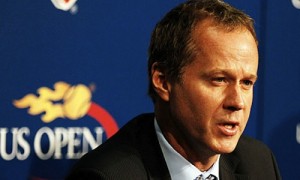
It has now been almost exactly four years to the day that Patrick McEnroe was named general manager of Elite Player Development for the USTA, charged with the responsibility of finding successors to Andy Roddick and the Willliams sisters and returning the U.S. to the dominance it once had when Pete Sampras, Andre Agassi, Jim Courier and Michael Chang were in their primes.
Four years in which the USTA has thrown tens of millions of dollars, including $15.7 million in 2010 alone and, presumably, a like amount in 2011, without producing anyone who even remotely resembles a future Grand Slam champion.
Maybe it’s still too early to judge the impact of the program? Maybe the next great U.S. player is some 15-year-old working at one of the Player Development training camps dotted around the country and who is within a year or two of asserting some prodigious talent.
Or maybe the USTA is wasting millions of dollars trying to do something that is best done at private academies, where young American talent not only competes against other young American talent, but against young, hungrier and more committed international talent.
There are good U.S. teenagers training at USTA camps in Boca Raton, Fla., at the Billie Jean King USTA National Tennis Center in Flushing, N.Y., and at the facility in Carson, Calif. No one debates that. And if the program had produced just one extraordinary player, who was either now impacting the game or who looks as if he, or she, will be among the game’s elite, the disturbing amounts of money being spent might not be an issue.
But that hasn’t happened and what you are left with is incredible expenditures. I can’t tell you what the USTA development program spent in 2011 until it files its Form 990 income tax report, but it’s expected to be about the same as for 2010 — a grand total of $15.7 million.
Let me repeat that figure — $15.7 million.
Where has $15.7 million gone?
* $809,000 to Patrick McEnroe, effectively the general manager, plus $238,000 in other compensation.
* $387,000 to prime coach Jose Higueras, plus $83,000 in other compensation.
* $273,000 to talent assessment expert Martin Blackman, plus $91,000 in other compensation.
* There are nine employes in the development program earning at least $152,000 annually, and that was 2010. The total salaries of those top coaches, plus a slew of lesser coaches and support staff came to $7.7 million. That’s for one year.
It’s no longer called Elite Player Development. It’s now USTA Player Development and, apparently, the mission statement has changed, too.
When former USTA executive for pro tennis Arlen Kantarian appointed McEnroe and made the announcement during the Key Biscayne tournament (which is being held this week), he said, “This is certainly an important day for American tennis and for the USTA. We’re here to talk about a new vision, new leadership, a new unified approach for elite player development, and one with a very, very specific goal, and that is to create the next generation of American champions.”
McEnroe added: “It’s time for us to step up and be accountable and make our system accountable to creating great players.”
Well, maybe it wasn’t precisely time for an accounting four years ago, but it certainly is today, and the public and those who support the USTA with their memberships are entitled to ask, “What are we getting for $15.7 million a year?”
That Kantarian remark four years ago was a bell ringer, but as you read through the 2010 Form 990 submitted to the federal government by the USTA, things don’t sound as challenging. The word “elite,” for example, is not used.
What the USTA tells the Internal Revenue Service people is that “in furtherance of USTA’s charitable purposes the goal of Player Development is to provide American junior, collegiate and young professional players the opportunities to reach their maximum potential.”
Is that worth $15.7 million a year?
It would take more patience than I have to recount the history of the USTA’s attempts at player development. It goes back well over 10 years, to a time when the USTA thought it could be a viable alternative to private academies, like the Bollettieri IMG Academy in Bradenton.
And every time the USTA has changed the structure of its player development plans, the price has gone up. When this latest version began four years ago, there was McEnroe and a handful of other coaches working out of the Evert Academy in Boca Raton. I doubt they were spending exorbitant amounts of money.
But every year more coaches were added. Then new training centers were added, requiring ever more more support staff.
One of the top coaches hired was former U.S. top-10 Tim Mayotte, who quit after a year and a half and wrote last September: “Now that we are at the end of another U.S. Open, the sad news is that American tennis is in the sorriest state it has ever been.”
Legitimate criticism? Or a man venting because he and Higueras had lengthy arguments over how to coach young American talent? Pick your alternative, though it probably doesn’t matter.
The bottom line is the U.S. has a long history of its best young talent being developed with private coaches and with a heavy impetus from families. Like Roddick. Like Mardy Fish. Like Agassi. Like Courier. Like the Williams sisters. Like Sampras. The USTA cannot rightfully claim it developed those players. They were all pushed along by committed parents and then private coaches.
But the USTA will continue to believe it can buy the next great American player, and it apparently won’t spare any expense in its belief.
Charles Bricker can be reached at nflwriterr@aol.com
